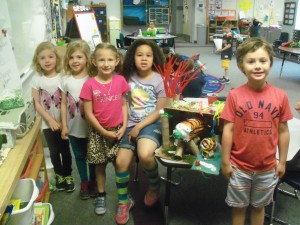 Yes, we have to do a research project in kindergarten!
Yes, we have to do a research project in kindergarten!
Like it or not, the Common Core State Standards clearly require this work. For one standard, students must “participate in shared research and writing projects.” Another states: students must “use a combination of drawing, dictating, and writing to compose informative/explanatory texts in which they name what they are writing about and supply some information about the topic.” And a third requires that, with guidance, students “gather information from provided sources to answer a question.”
Talk about stress—students who are just learning to read and write, who have to do research and write a report. It’s a challenge for everyone involved.
So last year we approached this differently than in the past, and ended up loving it.
Finding Animals
We began by choosing a handful of animals living at the Detroit Zoo. We pulled books from the library and magazines like Ranger Rick, and created easy-reader nonfiction books about these animals. We had these available in the classroom.
 We also looked for kid-appropriate videos and zoos that had viewing cameras on the animals. The San Diego Zoo, for example, has a lot of great animal cams.
We also looked for kid-appropriate videos and zoos that had viewing cameras on the animals. The San Diego Zoo, for example, has a lot of great animal cams.
We started off the unit talking about the three things animals need to survive: food, water, and shelter. We had a deck of cards, with each card listing one of the needs to survive. Students took turns pulling three cards. If they didn’t have one of each need, they sat down. If they received one of each, they were able to get back in line for another turn.
When more than half the class was sitting down, we started discussing what they noticed. We then led the conversation toward the students’ understanding that animals need food, water, and shelter to survive. This segued into a discussion about endangered animals as compared to extinct ones.
Thinking Like Scientists
The next lesson focused on scientists. We talked about how scientists would do research and what they might need or want to know. The class came up with these questions and then it was game on!
- What does the animal look like?
- Where does the animal live (habitat)?
- What does the animal eat?
- What are some interesting facts?
As a class, we were researching an animal to practice how to find the information. The students also split into small groups and chose an animal.
Before we started our research, we wrote on a chart page what we already knew, or thought we knew, about our chosen animal. Then each day we chose one of the driving questions to focus on. As a class, we found the answer for our class animal, and then the groups split off and went to work.
Some groups wanted to watch the videos, while others hunted through the books. They had a packet to complete together with the information they found.
The culmination of this research project was my favorite part. The students had to create a model of the animal, its habitat, and food source. We encouraged them to incorporate the interesting facts they learned, too, and instructed them to label items. When they were completed, we recorded a video of each group showing us what they created and answering our driving questions. Students were so excited to share what they had completed, and they were so proud of themselves.
We celebrated a wonderful learning unit by going to the Detroit Zoo and teaching our chaperones about the animals we studied. Needless to say, the parents were impressed!
 Tricia Ziegler (Twitter: @axf96; blog: http://kindergartentreasures.blogspot.com/) is a kindergarten teacher at Loon Lake Elementary, in the Walled Lake School District. She recently became part of the Walled Lake Teacher Leader Fellowship. She is in her tenth year of teaching, with eight in kindergarten and two in Second Grade. Prior to that she taught in the Walled Lake Great Start Readiness Program, which is a state-funded preschool program for at-risk students. Tricia attended Michigan State University for her undergraduate degree and specialization in Early Childhood. She then attended Wayne State University for her Master’s in Teacher Education.
Tricia Ziegler (Twitter: @axf96; blog: http://kindergartentreasures.blogspot.com/) is a kindergarten teacher at Loon Lake Elementary, in the Walled Lake School District. She recently became part of the Walled Lake Teacher Leader Fellowship. She is in her tenth year of teaching, with eight in kindergarten and two in Second Grade. Prior to that she taught in the Walled Lake Great Start Readiness Program, which is a state-funded preschool program for at-risk students. Tricia attended Michigan State University for her undergraduate degree and specialization in Early Childhood. She then attended Wayne State University for her Master’s in Teacher Education.

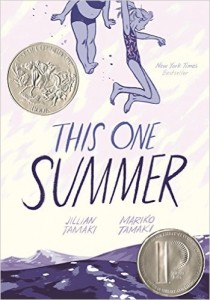 The Great Graphic Novel Experiment is in full swing in my classroom. In fact, it has become the focal point of my passions this year. I’ve been so vocal about it that my wife and kids actually bought me a couple graphic novels for my birthday. I’m “all in,” as Matt Damon says in the film Rounders.
The Great Graphic Novel Experiment is in full swing in my classroom. In fact, it has become the focal point of my passions this year. I’ve been so vocal about it that my wife and kids actually bought me a couple graphic novels for my birthday. I’m “all in,” as Matt Damon says in the film Rounders.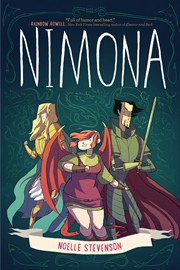 I could go on, but I think the broader point is more important: these are stories that will speak to any reader. I passed along two of the aforementioned titles to other people in my department, who sent back rave reviews—and then sent along new titles of their own! Nimona, a work of fantasy, and the graphic novelization of Mrs. Peregrine’s Home for Peculiar Children are now in my queue.
I could go on, but I think the broader point is more important: these are stories that will speak to any reader. I passed along two of the aforementioned titles to other people in my department, who sent back rave reviews—and then sent along new titles of their own! Nimona, a work of fantasy, and the graphic novelization of Mrs. Peregrine’s Home for Peculiar Children are now in my queue.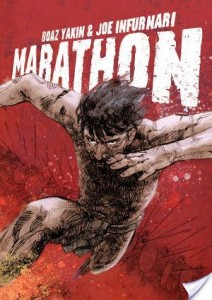 And what’s more, other research hints that such visual reading may also maximize a reader’s ability to retain information. That might not seem like a key merit for pleasure reading. But consider how many graphic novels have been written about historical events and culturally relevant topics: Marathon, about the Greek tale of that famous run; Templar, about what became of that famous secret society; and Americus, about censorship in literature. They’re all fiction, but still dense with contextual facts that the research suggests students will retain.
And what’s more, other research hints that such visual reading may also maximize a reader’s ability to retain information. That might not seem like a key merit for pleasure reading. But consider how many graphic novels have been written about historical events and culturally relevant topics: Marathon, about the Greek tale of that famous run; Templar, about what became of that famous secret society; and Americus, about censorship in literature. They’re all fiction, but still dense with contextual facts that the research suggests students will retain.
 Recently I had the pleasure to conduct professional learning sessions on literacy with three separate groups of teachers. The teachers spanned every discipline, which is understandable, given the trends in education throughout the country.
Recently I had the pleasure to conduct professional learning sessions on literacy with three separate groups of teachers. The teachers spanned every discipline, which is understandable, given the trends in education throughout the country.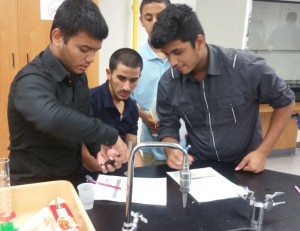
 Rick Joseph is a National Board Certified Teacher and has taught 5/6 grade at Covington School in the Birmingham Public School district since 2003. Prior, he served as a bilingual educator and trainer for nine years in the Chicago Public Schools. Rick is thrilled to serve as the 2016 Michigan Teacher of the Year. Through Superhero Training Academy, Rick’s students have created a superhero identity to uplift the communities where they learn and live.
Rick Joseph is a National Board Certified Teacher and has taught 5/6 grade at Covington School in the Birmingham Public School district since 2003. Prior, he served as a bilingual educator and trainer for nine years in the Chicago Public Schools. Rick is thrilled to serve as the 2016 Michigan Teacher of the Year. Through Superhero Training Academy, Rick’s students have created a superhero identity to uplift the communities where they learn and live.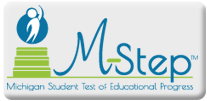

 Jianna Taylor (
Jianna Taylor ( Years ago, in a jaded moment of teaching frustration, I purchased a book entitled
Years ago, in a jaded moment of teaching frustration, I purchased a book entitled  In that sense, the focus of English classrooms has been off for a long time. We build our units around a core canonical text, and make everything else more or less in service of that text. Is our concern whether kids learn to love reading, or do we press them to love this book at this moment, because it’s what we believe people who love reading should value?
In that sense, the focus of English classrooms has been off for a long time. We build our units around a core canonical text, and make everything else more or less in service of that text. Is our concern whether kids learn to love reading, or do we press them to love this book at this moment, because it’s what we believe people who love reading should value?